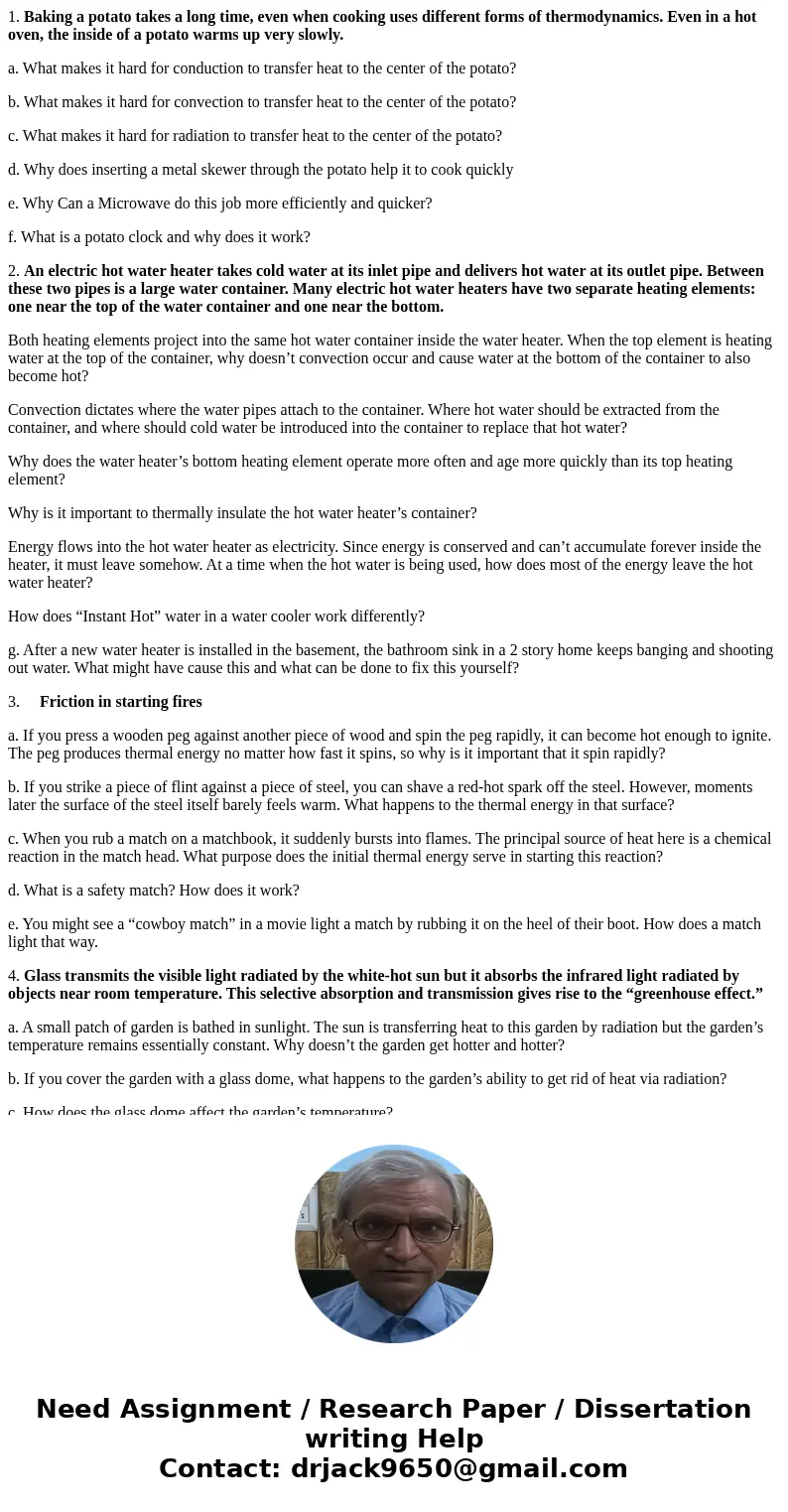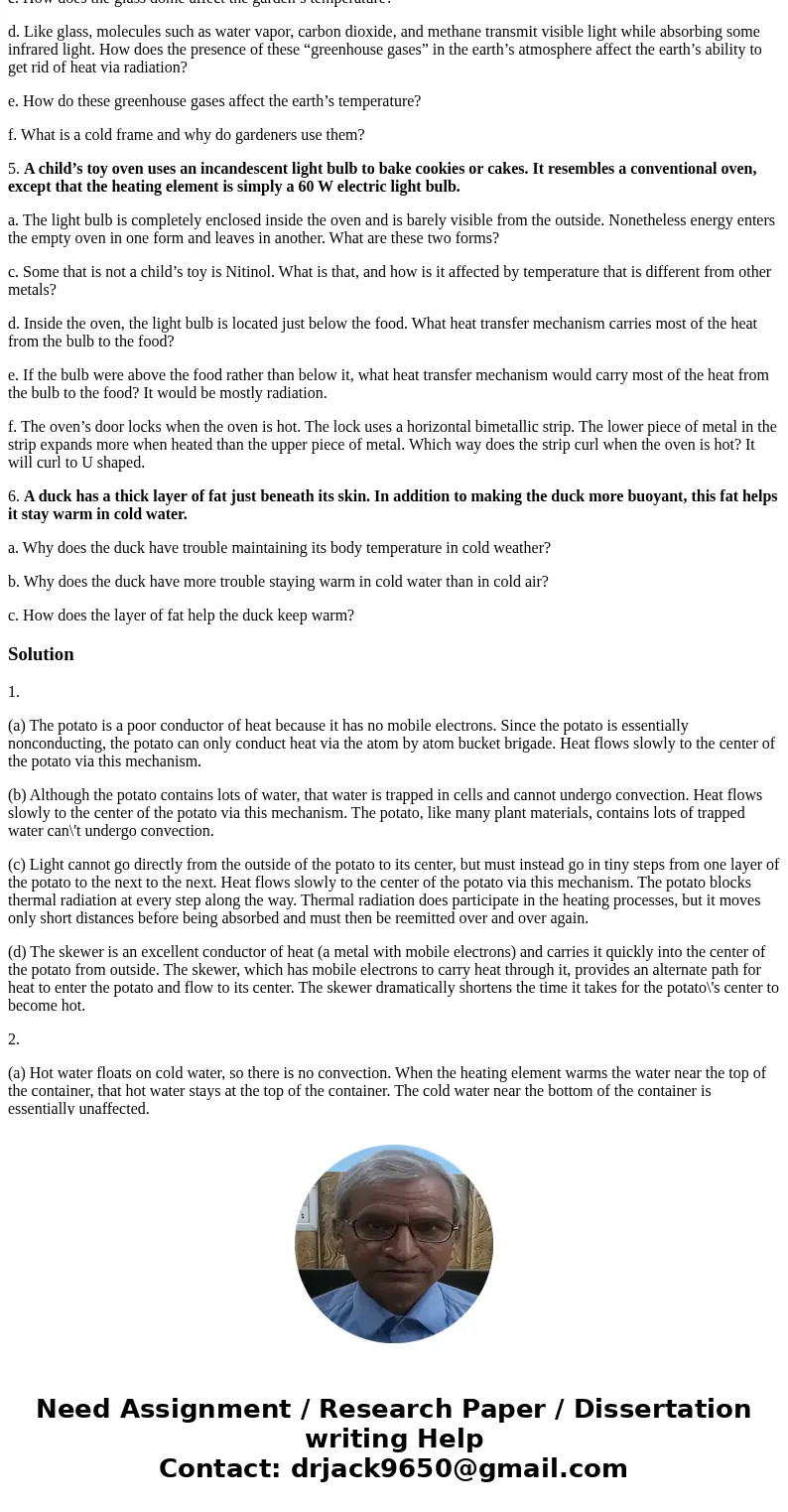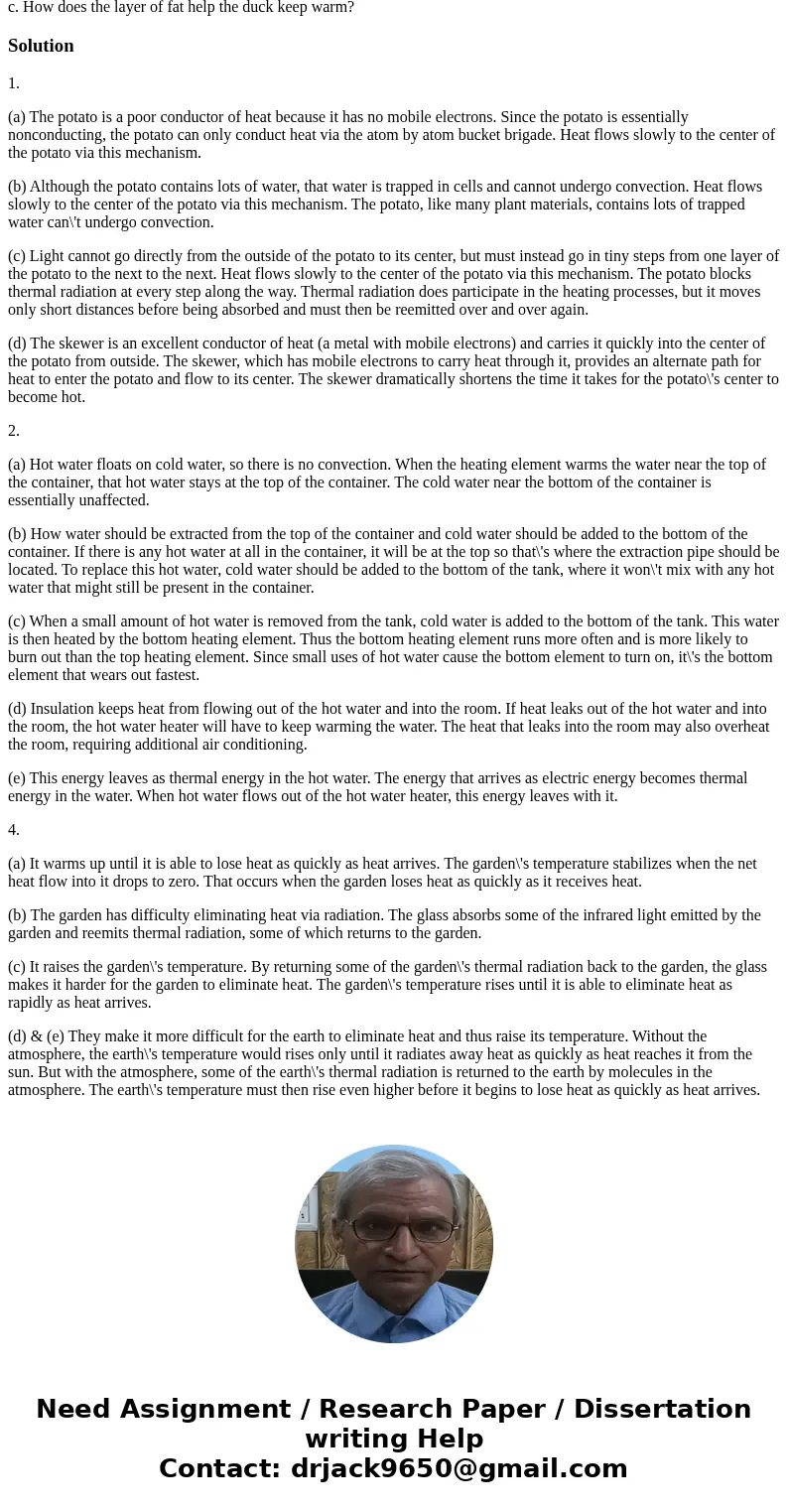1 Baking a potato takes a long time even when cooking uses d
1. Baking a potato takes a long time, even when cooking uses different forms of thermodynamics. Even in a hot oven, the inside of a potato warms up very slowly.
a. What makes it hard for conduction to transfer heat to the center of the potato?
b. What makes it hard for convection to transfer heat to the center of the potato?
c. What makes it hard for radiation to transfer heat to the center of the potato?
d. Why does inserting a metal skewer through the potato help it to cook quickly
e. Why Can a Microwave do this job more efficiently and quicker?
f. What is a potato clock and why does it work?
2. An electric hot water heater takes cold water at its inlet pipe and delivers hot water at its outlet pipe. Between these two pipes is a large water container. Many electric hot water heaters have two separate heating elements: one near the top of the water container and one near the bottom.
Both heating elements project into the same hot water container inside the water heater. When the top element is heating water at the top of the container, why doesn’t convection occur and cause water at the bottom of the container to also become hot?
Convection dictates where the water pipes attach to the container. Where hot water should be extracted from the container, and where should cold water be introduced into the container to replace that hot water?
Why does the water heater’s bottom heating element operate more often and age more quickly than its top heating element?
Why is it important to thermally insulate the hot water heater’s container?
Energy flows into the hot water heater as electricity. Since energy is conserved and can’t accumulate forever inside the heater, it must leave somehow. At a time when the hot water is being used, how does most of the energy leave the hot water heater?
How does “Instant Hot” water in a water cooler work differently?
g. After a new water heater is installed in the basement, the bathroom sink in a 2 story home keeps banging and shooting out water. What might have cause this and what can be done to fix this yourself?
3. Friction in starting fires
a. If you press a wooden peg against another piece of wood and spin the peg rapidly, it can become hot enough to ignite. The peg produces thermal energy no matter how fast it spins, so why is it important that it spin rapidly?
b. If you strike a piece of flint against a piece of steel, you can shave a red-hot spark off the steel. However, moments later the surface of the steel itself barely feels warm. What happens to the thermal energy in that surface?
c. When you rub a match on a matchbook, it suddenly bursts into flames. The principal source of heat here is a chemical reaction in the match head. What purpose does the initial thermal energy serve in starting this reaction?
d. What is a safety match? How does it work?
e. You might see a “cowboy match” in a movie light a match by rubbing it on the heel of their boot. How does a match light that way.
4. Glass transmits the visible light radiated by the white-hot sun but it absorbs the infrared light radiated by objects near room temperature. This selective absorption and transmission gives rise to the “greenhouse effect.”
a. A small patch of garden is bathed in sunlight. The sun is transferring heat to this garden by radiation but the garden’s temperature remains essentially constant. Why doesn’t the garden get hotter and hotter?
b. If you cover the garden with a glass dome, what happens to the garden’s ability to get rid of heat via radiation?
c. How does the glass dome affect the garden’s temperature?
d. Like glass, molecules such as water vapor, carbon dioxide, and methane transmit visible light while absorbing some infrared light. How does the presence of these “greenhouse gases” in the earth’s atmosphere affect the earth’s ability to get rid of heat via radiation?
e. How do these greenhouse gases affect the earth’s temperature?
f. What is a cold frame and why do gardeners use them?
5. A child’s toy oven uses an incandescent light bulb to bake cookies or cakes. It resembles a conventional oven, except that the heating element is simply a 60 W electric light bulb.
a. The light bulb is completely enclosed inside the oven and is barely visible from the outside. Nonetheless energy enters the empty oven in one form and leaves in another. What are these two forms?
c. Some that is not a child’s toy is Nitinol. What is that, and how is it affected by temperature that is different from other metals?
d. Inside the oven, the light bulb is located just below the food. What heat transfer mechanism carries most of the heat from the bulb to the food?
e. If the bulb were above the food rather than below it, what heat transfer mechanism would carry most of the heat from the bulb to the food? It would be mostly radiation.
f. The oven’s door locks when the oven is hot. The lock uses a horizontal bimetallic strip. The lower piece of metal in the strip expands more when heated than the upper piece of metal. Which way does the strip curl when the oven is hot? It will curl to U shaped.
6. A duck has a thick layer of fat just beneath its skin. In addition to making the duck more buoyant, this fat helps it stay warm in cold water.
a. Why does the duck have trouble maintaining its body temperature in cold weather?
b. Why does the duck have more trouble staying warm in cold water than in cold air?
c. How does the layer of fat help the duck keep warm?
Solution
1.
(a) The potato is a poor conductor of heat because it has no mobile electrons. Since the potato is essentially nonconducting, the potato can only conduct heat via the atom by atom bucket brigade. Heat flows slowly to the center of the potato via this mechanism.
(b) Although the potato contains lots of water, that water is trapped in cells and cannot undergo convection. Heat flows slowly to the center of the potato via this mechanism. The potato, like many plant materials, contains lots of trapped water can\'t undergo convection.
(c) Light cannot go directly from the outside of the potato to its center, but must instead go in tiny steps from one layer of the potato to the next to the next. Heat flows slowly to the center of the potato via this mechanism. The potato blocks thermal radiation at every step along the way. Thermal radiation does participate in the heating processes, but it moves only short distances before being absorbed and must then be reemitted over and over again.
(d) The skewer is an excellent conductor of heat (a metal with mobile electrons) and carries it quickly into the center of the potato from outside. The skewer, which has mobile electrons to carry heat through it, provides an alternate path for heat to enter the potato and flow to its center. The skewer dramatically shortens the time it takes for the potato\'s center to become hot.
2.
(a) Hot water floats on cold water, so there is no convection. When the heating element warms the water near the top of the container, that hot water stays at the top of the container. The cold water near the bottom of the container is essentially unaffected.
(b) How water should be extracted from the top of the container and cold water should be added to the bottom of the container. If there is any hot water at all in the container, it will be at the top so that\'s where the extraction pipe should be located. To replace this hot water, cold water should be added to the bottom of the tank, where it won\'t mix with any hot water that might still be present in the container.
(c) When a small amount of hot water is removed from the tank, cold water is added to the bottom of the tank. This water is then heated by the bottom heating element. Thus the bottom heating element runs more often and is more likely to burn out than the top heating element. Since small uses of hot water cause the bottom element to turn on, it\'s the bottom element that wears out fastest.
(d) Insulation keeps heat from flowing out of the hot water and into the room. If heat leaks out of the hot water and into the room, the hot water heater will have to keep warming the water. The heat that leaks into the room may also overheat the room, requiring additional air conditioning.
(e) This energy leaves as thermal energy in the hot water. The energy that arrives as electric energy becomes thermal energy in the water. When hot water flows out of the hot water heater, this energy leaves with it.
4.
(a) It warms up until it is able to lose heat as quickly as heat arrives. The garden\'s temperature stabilizes when the net heat flow into it drops to zero. That occurs when the garden loses heat as quickly as it receives heat.
(b) The garden has difficulty eliminating heat via radiation. The glass absorbs some of the infrared light emitted by the garden and reemits thermal radiation, some of which returns to the garden.
(c) It raises the garden\'s temperature. By returning some of the garden\'s thermal radiation back to the garden, the glass makes it harder for the garden to eliminate heat. The garden\'s temperature rises until it is able to eliminate heat as rapidly as heat arrives.
(d) & (e) They make it more difficult for the earth to eliminate heat and thus raise its temperature. Without the atmosphere, the earth\'s temperature would rises only until it radiates away heat as quickly as heat reaches it from the sun. But with the atmosphere, some of the earth\'s thermal radiation is returned to the earth by molecules in the atmosphere. The earth\'s temperature must then rise even higher before it begins to lose heat as quickly as heat arrives.



 Homework Sourse
Homework Sourse